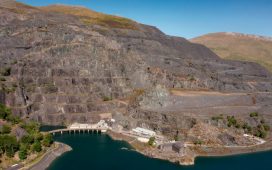Unlock the Editor’s Digest for free
Roula Khalaf, Editor of the FT, selects her favourite stories in this weekly newsletter.
The Scottish government is on a “mission” to pursue private finance for green industries to fill the gap left by a declining oil sector, the deputy first minister has said, adding that higher rates of income tax cannot be raised “continually”.
Kate Forbes said the government was in talks with institutional investors from around the world seeking to expand into Scotland’s clean power sectors, especially where the country has competitive advantages, such as floating offshore wind.
The Scottish National party, which was routed in the UK general election in July, faces another test in the 2026 Holyrood elections, when Labour will seek to oust the SNP-led government.
“In the next 18 months, I have a very clear mission — to mercilessly pursue investment in Scotland’s transition, to give very clear signals that we value private investment and that it is straightforward, simple and well received,” she said in an interview.
The government was responding to investor feedback calling for it to foster a more attractive investment environment, she added.
Some companies have pointed to higher rates of income tax on wealthier residents as a disincentive to investment in Scotland.
Forbes said taxpayers need certainty and “you cannot continually raise tax”. But she said, “in the round”, the lower cost of living in Scotland made the country a very attractive proposition.
“It is our job to shout this from the rooftops, every rooftop in the world,” she added.
First minister John Swinney, who brought Forbes back into the prominent government position in May, has made investment central to his campaign to deliver on the public’s demands, such as more jobs and better services.
Forbes said the government’s green industrial strategy, released on Wednesday, was a “prospectus for the market” focusing on five sectors: wind energy, carbon capture and storage, green professional and financial services, hydrogen and the electrification of heavy industry.
Scotland has had some successes in recent years, including Sumitomo’s cable factory in Nigg, she said, but “we have more to do in terms of locating the supply chain here to create more highly paid, secure jobs”.
The strategy outlines more proactive plans to structure opportunities alongside a promotion campaign, including hosting a global offshore wind investment forum next year. The government will also shortlist projects for state support, such as a “concierge service” to support delivery and operations.
Claire Mack, of industry body Scottish Renewables, welcomed the strategy’s promise to drive investment but warned that “it is delivery that counts”.
“The Scottish government must hold itself accountable for what has been announced,” she said.
Forbes pledged to deliver “multiple” deals akin to Sumitomo’s, a growing domestic supply chain, as well as progressing newer industries such as battery storage and hydrogen, within the first year of the new strategy.
“The private sector is not obliged to come to Scotland — it will look for the most favourable conditions,” she said. “I think we have that in Scotland, but we need to be clear in articulating what those opportunities are.”
The strategy identifies wind power as “the single most important immediate opportunity for attracting mobile capital to Scotland at scale”.
Scotland has a potential pipeline of more than 40GW of offshore wind projects and could support between 10,400-54,000 jobs in the coming decades, it said.
Forbes said the government would also work to remove barriers to investment, such as delays in giving planning consent for offshore wind projects, a power that is devolved to Holyrood.









